#YogaHistory
Text
A Short Introduction to the Yoga Sutras

The Yoga Sutras are generally considered a foundational text of the yoga tradition. In this article we examine the context and background of the text, briefly explore its structure and content, and I also offer some reflections on the text’s relevance in modern times.
Note: I have decided not to use diacritics in this article. Diacritics are those little lines and dots above and below letters that tell you how to pronounce Sanskrit words. Normally I use diacritics in my writing, as they are essential for pronouncing Sanskrit correctly. However as this article is meant for non-scholars I have decided it would be better to try and write the Sanskrit words in a way that will make them easy to read and pronounce, so as not to put anybody off!
History & Context
Most scholars these days date the Yoga Sutras to somewhere between the 2nd and 5th centuries CE, with Philipp Maas placing it in the early 5th century.
The text is attributed to a sage named Patanjali. Biographically, we know next to nothing about Patanjali. The name is a compound word formed from the Sanskrit words pata (falling, flying) and anjali (the gesture of joining the hands together in reverence).
Yoga had already been around in some form or another for many centuries by this point. Therefore, Patanjali did not ‘invent’ Yoga. Nevertheless, this is the earliest comprehensive and systematic text on the subject that has survived.
Yoga was just one darshana or school out of many in ancient India. In terms of philosophy, it shares many similarities with the Samkhya school. But whereas Samkhya tends to emphasise the use of reason and knowledge to gain liberation, Yoga emphasises practical and experiential methods.
Philosophically, both the Samkhya and Yoga schools teach a form of dualism. This is a dualism between purusha (our true Self) and prakriti (everything else, including the body and mind) and the whole point of Samkhya and Yoga in a nutshell is to guide us towards the realisation of purusha, that is, our true Self. This is true liberation or moksha in Yoga.
Most of the ancient darshanas had their own sutra text. Sutra texts are known for their brevity. Basically, sutra texts are where the most essential teachings of a school are distilled into as few words as possible. Knowledge systems were handed down orally in ancient India and thus source material was kept minimal with a view to facilitating memorisation.
Other authors would then come along and write longer commentaries on these sutra texts. The Yoga Sutras have a rich commentarial tradition spanning many centuries. The first and most well known is the bhasya commentary by a certain Vyasa. Vyasa actually means something like ‘compiler’ or ‘editor’ so that probably wasn’t his actual name!
Some scholars even argue that Patanjali and Vyasa are actually one and the same person, though others would strongly disagree with this thesis. Either way, this commentary is indispensable when it comes to making sense of the sutras, and published versions of the Yoga Sutras tend to include the bhasya commentary or at least reference it.
As a final note, many scholars now use the term pātañjalayogaśāstra to refer to this text as a whole (sutras plus commentary), because that is the name our oldest existing manuscripts use. But to keep things simple we will continue to use the name Yoga Sutras!

Structure of the Text
The Yoga Sutras are divided into the following four padas or chapters:
Samadhi Pada: This is where Patanjali defines Yoga and then describes the nature and the means to samadhi, the goal of Yoga.
Sadhana Pada: Sadhana is the Sanskrit word for practice or discipline. Here the author outlines two forms of Yoga, the kriya yoga (yoga of action) and the ashtanga yoga (the yoga of eight auxiliaries or limbs). This is also where Patanjali discusses the kleshas, five ‘afflictions’ or impediments to Yoga.
Vibhuti Pada: Vibhuti is the Sanskrit word for power or manifestation. Supra-normal powers (siddhis) are said to be acquired by the practice of Yoga. However, the temptation of these powers should be avoided and the attention should ultimately be fixed only on liberation.
Kaivalya Pada: Kaivalya literally means isolation. This is the chapter on final liberation. The Kaivalya Pada describes the process of liberation, it explains how the mind is constructed and veils the inner light of the Self.
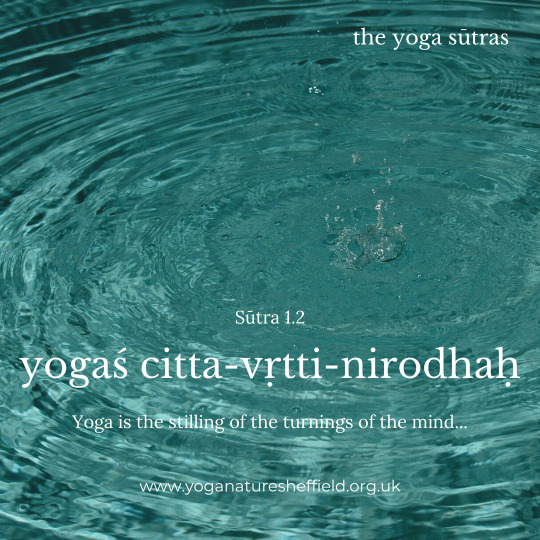
The Goal of Yoga
Not one for a lengthy preamble, Patanjali gets stuck right in there and clearly states the goal of Yoga in the well-known second sutra:
yogas chitta-vritti-nirodhah YS 1.2
Any Sanskrit sentence allows for a number of possible translations and this one is no different. A nice and accurate one is this one from Barbara Stoler Miller:
Yoga is the cessation of the turnings of thought
The reason I say this one is accurate is because a literal meaning of vritti is ‘turning’. Ever felt that thoughts are ‘going round and round’ in your head? Well this phrase nicely captures that! The vrittis in this statement refer to thoughts, emotions, ideas and basically any cognitive act of the mind. Patanjali lists five types of vrittis. These are, once translated:
Right knowledge
Error or false knowledge
Imagination
Sleep &
Memory
All such activities of the mind are products of prakriti and are completely distinct from the true Self, purusha, that pure awareness or consciousness which we are aiming to enter into through Yoga. The means prescribed by Patanjali in the first chapter of the Yoga Sutras to still the vritti states of mind are sustained practice (abhyasa) and dispassion (vairagya).
Specifically the practice offered is meditation, or keeping the mind fixed on any particular object of choice without distraction. Patanjali then describes a number of possible forms such meditation could take. By stilling all thought, meditation removes all objects of awareness. Awareness can therefore now be aware only of itself, of its own source, the true Self or purusha. This state is known as samadhi in Yoga and Patanjali makes it super clear that this state of samadhi is the goal of Yoga and thus the whole text is focused upon achievement of that goal.

Obstacles to Yoga
Patanjali mentions five kleshas, which can be translated as impediments or obstacles to achieving samadhi and thus Yoga. These five are as follows:
Ignorance
Ego
Desire
Aversion
Clinging
In the Yoga Sutras, and indeed in ancient Indian philosophy in general, the first item in any list is the most important and fundamental. It’s the same here. Ignorance here means failing to recognise our true Self or purusha and instead identifying ourselves with our body, mind and the material world. All of the other obstacles arise from this fundamental error.
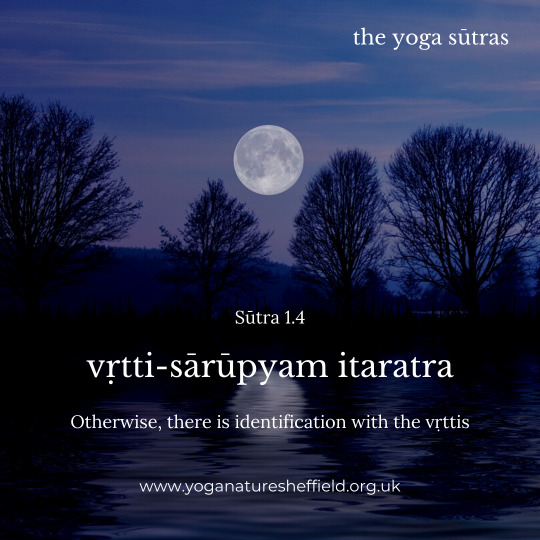
Yoga Psychology
Like most other schools of Indian thought, the Yoga school believed in the related concepts of karma and rebirth. According to this doctrine, we are caught in an endless cycle of rebirths called samsara and the purpose of following a path such as Jainism, Buddhism or Yoga is to bring an end to this cycle. Where the Yoga Sutras really shine are in interpreting this doctrine in a highly sophisticated ‘psychological’ way, to use modern terminology.
According to this Yoga psychology, the mind forms an impression of an object through the sense organs, which is called a pratyaya. Once this pratyaya or active image of this object is no longer of active interest to the mind, it becomes an inactive or latent samskara. A samskara is an imprint left in the chitta, somewhat like a sound is imprinted on a tape recorder, or an image on photographic film. In this way the vrittis, the activities of the mind, are retained as samskaras when they fade.
It is important to note that these samskaras are not just passive imprints but vibrant latent impulses that can get activated under conducive circumstances and can exert influence on a person’s thoughts and behaviours, even many years after the impression was made. What’s more, according to Yoga these samskaras can persist from previous lives. The chitta is thus something of a storehouse of these recorded samskaras, deposited and accumulated there over countless lifetimes. One is here reminded of the theory of the subconscious in modern psychoanalysis.
According to Yoga, karma is generated by the vrittis, and the vrittis, in turn, are produced by the kleshas. There is thus a vicious cycle of kleshas, vrittis and samskaras. To run through the whole cycle again to try and make it as clear as possible: vrittis are recorded in the chitta as samskaras, and these samskaras eventually activate consciously or subliminally, producing further vrittis. These vrittis then provoke actions and reactions, which in turn are recorded as samskaras, and the cycle continues endlessly, leading to much suffering along the way.
The whole Yoga project aims to bring this vicious cycle to an end and it is liberation from this mind created suffering that we are after as yogis. The Yoga Sutras are effectively a manual guiding us towards this end, this state of samadhi or complete meditative consciousness.

The Yamas and Niyamas
The second pada or chapter of the Yoga Sutras contains a famous exposition of five ethical restraints (yamas) and five ethical observances (niyamas) and these are relatively well-known in the modern yoga world. The first thing to get clear is that these yamas and niyamas are NOT original or unique to Yoga. All ascetic schools in ancient India had these ethical codes, and the exact same ones appear in Jainism for example. Sometimes, you even get more of them. Some yoga texts for instance list 10 yamas and 10 niyamas.
The five yamas listed in the Yoga Sutras are:
Ahimsa (non-harming)
Satya (truth telling)
Asteya (non-stealing)
Brahmacharya (chastity or celibacy)
Aparigraha (non-acquisitiveness)
The five niyamas are:
Shauca (purity or cleanliness)
Santosha (contentment)
Tapas (self-discipline)
Svadhyaya (study)
Ishvarapranidhana (devotion to the Ishvara or Lord)
Many of these could do with further explanation and commentary but there is not space in this present article. The other thing I want to stress is that these yamas and niyamas were not seen as optional extras for yogis. Rather, these were the bedrock of fruitful yoga practice. Patanjali and others refer to them as the mahavratam or ‘great vow’. Importantly, having listed the yamas, Patanjali devotes an entire sutra to reiterating just how central and non-negotiable these yamas are. Once translated, this sutra reads as follows:
[These yamas] are considered the great vow. They are not exempted by one’s class, place, time or circumstance. They are universal. YS 2.31
So, regardless of your social status, regardless of where you live, in which time period you live, and any other extenuating circumstances (such as your career), adherence to the yamas, including especially ahimsa, the foundation of them all, is an essential part of being a yogi as defined by Patanjali’s system.
Vyasa is even more emphatic in his bhasya commentary to the Yoga Sutras, and it is here that the link between ahimsa and vegetarianism is explicitly and unequivocally made, and several examples are brought to bear. Refer to the work of scholar Jonathan Dickstein to read more about the strong case for vegetarianism made in Patanjali Yoga.
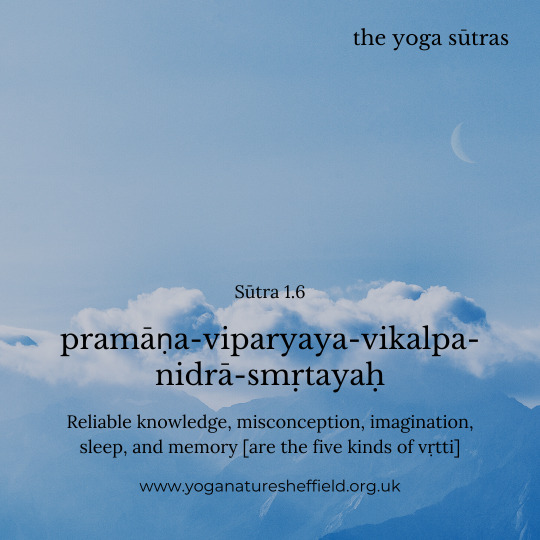
The Ashtanga Yoga
These yamas and niyamas are just the first two parts of Patanjali’s famous ashtanga or eight-part path. I would first like to clarify that this systematisation of yoga into a series of angas (a word translated by some modern scholars as ‘auxiliaries’ but more commonly rendered as ‘limbs’) was again not novel to Patanjali. Throughout the yoga tradition we find various similar schemes, predating and postdating Patanjali, including fourfold, fivefold, sevenfold and even fifteenfold schemes. I would also like to stress that, despite sharing the same name, this ashtanga yoga bears little relation to the modern postural form of yoga known as Ashtanga.
Following the yamas and niyamas then, we then have the following six angas:
Asana (posture): At last I hear you cry, postures! In Patanjali’s day meaning a steady and comfortable seated posture, asanas today comprise a set of physical exercises which stretch and strengthen the body. It is this aspect of yoga that has been most visibly exported to the West but too often stripped from its context as just one ingredient in a more ambitious and far-reaching sequence.
Pranayama (breath control): Prana refers to the universal life force whilst ayama means to regulate or control, but it can also mean to expand and lengthen. Prana is the vital energy needed by our physical and subtle layers, without which the body would perish. It is what keeps us alive. Pranayama is thus the control or expansion of prana through the breath, depending on which definition of ayama you use.
Pratyahara (withdrawal of the senses): This limb further deepens the above process by removing consciousness from all engagement with the senses (sight, sound, taste, smell and touch) and sense objects.
This is followed by the final three limbs collectively known as samyama: Dharana (concentration, fixation), Dhyana (meditation), and finally Samadhi (the latter of which Patanjali further divides into seven rather esoteric stages). These last three limbs are essentially different degrees of concentrative intensity and culminate in the realisation by the Self of its own nature.
Just to reiterate one more time, it is this Self-realisation, the state known as samadhi, that is the true goal of Yoga.
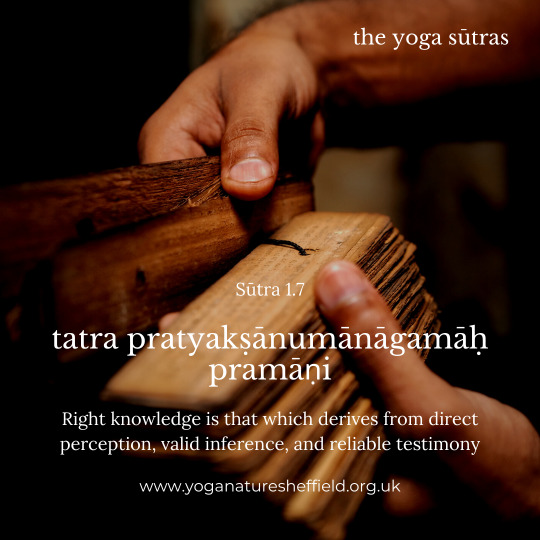
Relevance of the Yoga Sutras for Today
In this brief introduction we have of course only scratched the surface of this incredible text, and there is much more that could be said. But for now I want to end with some concluding reflections on the continuing relevance of the Yoga Sutras in the modern world.
One question that arises is whether Patanjali was prescribing a strictly ascetic path. And indeed, the general scholarly consensus has usually been to associate Patanjali's Yoga exclusively with extreme asceticism, mortification, denial and renunciation. However, there are dissenting vocies. For example, Ian Whicher has repeatedly and passionately argued that Patanjali's Yoga can be seen as enabling a more responsible living in and engagement with the world, and that Patanjali was not advocating total renunciation. For Whicher, following the path of Patanjali can lead one towards that integrated and embodied state of liberated selfhood whilst living, a state known as jivanmukti.
Regardless of whether Patanjali was historically preaching ascetism or not, the fact remains that the Yoga Sutras are full of valuable ideals and tools for the practitioner living in the modern world. Let’s face it though, this is a challenging path. As a scholar and practitioner I often perceive a huge disconnect between the kind of yoga I am seeing on the likes of Instagram and the teachings of the Yoga school as presented in the Yoga Sutras. After, all, the former is highly focused on body image, whereas the Yoga of Patanjali is all about dissociating ourselves from our body and mind and recognising our true Self. However, this does not mean that the two are necessarily irreconcilable.
Though there is absolutely no historical evidence that Patanjali and his followers were practicing postural yoga (that didn’t come until later with the emergence of the Hatha tradition) nowhere in the Yoga Sutras does it say that physical exercise cannot be part of one’s yoga practice. We just have to remember that as far as Patanjalian Yoga is concerned, such postural activity is just a further means or method on the path towards samadhi or full meditative awareness. This is why any so-called yoga that does not contain more internalised meditational practices but which focuses solely on physical exercise should not really be called yoga.
The Yoga Sutras remains undoubtedly the most famous ancient yoga text, and it is studied to some extent in probably every yoga teacher training course. To be honest, I personally feel that too much emphasis is placed on the Yoga Sutras, at the expense of other branches and other texts of the tradition. The Tantric texts, in particular, are still sorely neglected. One of my own aims in my work is to try and decentre the Yoga Sutras and provide a much wider overview of the history and philosophy of yoga and the other related schools of ancient India. This is not to take anything away from the Yoga Sutras, however, as it is without doubt an extraordinary text that continues to be highly relevant in the 21st century.
Further Reading
I have already mentioned some scholars whose work you may wish to refer to, such as Philipp André Maas, Ian Whicher and Barbara Stoler Miller. For a translation and commentary on the Yoga Sutras that is both scholarly accurate and reasonably accessible I would recommend that of Edwin Bryant published by North Point Press.
7 notes
·
View notes
Text

History of Yoga
The first mention of the word “yoga” appears in Rig Veda, a collection of ancient texts. Yoga comes from the Sanskrit word “yuj,” which means “union” or “to join.”
Yoga can be traced back to northern India over 5,000 years ago.
Indian monks spread their knowledge of yoga in the West during the late 1890s. Modern yoga teachings became widely popular in Western countries by the 1970s.
.
𝐅𝐨𝐫 𝐈𝐧𝐪𝐮𝐢𝐫𝐢𝐞𝐬 & 𝐌𝐨𝐫𝐞 𝐃𝐞𝐭𝐚𝐢𝐥𝐬:
Website: https://aatmyogashala.com/
Call OR WhatsApp: +91-8445993766
E-mail: [email protected]
#history#yogattcinrishikesh#yogahistory#yogaforall#ancientyoga#yogainindia#yogaschoolinrishikesh#yogaclasses#yogatraining#yogattc#yogavariation#hathayoga#ashtangayoga#yogapractice#AatmYogashala
2 notes
·
View notes
Text

Proper Exercises (Asanas): Yoga postures are designed to strengthen, stretch, and balance the body. They can also help to improve flexibility, reduce stress, and promote relaxation.
Proper Breathing (Pranayama): Yoga breathing exercises help to regulate the breath and improve the flow of oxygen throughout the body. They can also help to reduce stress, improve focus, and increase energy levels.
Proper Relaxation: Yoga relaxation techniques, such as savasana (corpse pose), help to calm the mind and body. They can be beneficial for reducing stress, improving sleep, and promoting overall well-being.
Proper Diet and Nutrition: A healthy diet is essential for overall health and well-being. Yoga practitioners are encouraged to eat a balanced diet that includes plenty of fruits, vegetables, and whole grains.
Meditation and Positive Thinking: Meditation and positive thinking are important aspects of yoga practice. Meditation can help to quiet the mind and focus the attention, while positive thinking can help to cultivate a more optimistic outlook on life.
#yogamotivation#yoga#asanas#yog#yogahistory#yogainspiration#meditation#hathayoga#yogadiversity#principles of yoga
2 notes
·
View notes
Text
youtube
"Health Matters Live: Celebrating International Yoga Day 2023 with Rapha Live!"#yogaday2023 #yoga
Welcome to "Health Matters Live," your ultimate source for live news updates on crucial health topics! Join us for an engaging live-streaming session as our expert panellists provide opinions and insights on International Yoga Day! Some of the questions that might be in your mind are: "What is the history of yoga and its origins?" "Who are some important yogis that have influenced the practice?" "What are some popular yoga asanas (postures) and their benefits?" Stay informed, ask questions, and gain valuable insights into the significance and practice of yoga on this International Yoga Day. We request you to sign up for this form to show interest in the yoga day package, https://docs.google.com/forms/d/e/1FA... Your feedback will help us provide content relevant to your health-promoting interests. Before watching the video, do not forget to SUBSCRIBE to this channel to receive many more tips. For professional help and tools, download our mobile app: Android: http://bit.ly/3JACQOb Apple: https://apple.co/3I0QKbe Explore at www.raphacure.com or write to [email protected]. #HealthMattersLive #HealthNewsUpdates #StayInformed #LiveHealthDiscussion #MedicalExpertPanel #HealthcareAdvancements #AskTheExperts #InternationalYogaDay #YogaHistory #ImportantYogis #YogaAsanas #SoundTherapy #azadikaamritmahotsav #internationalyogaday2023 #raphacure #raphalive #raphaclinic #pmoindia #g20india Latest news update: Latest news up The latest news update today Latest news updates Malayalam Latest news updates in Telugu Latest news updates in Hindi The latest news update
#HealthMattersLive#HealthNewsUpdates#StayInformed#LiveHealthDiscussion#MedicalExpertPanel#HealthcareAdvancements#AskTheExperts#InternationalYogaDay#YogaHistory#ImportantYogis#YogaAsanas#SoundTherapy#azadikaamritmahotsav#internationalyogaday2023#raphacure#raphalive#raphaclinic#pmoindia#g20india#Youtube
0 notes
Photo

Did you know that the first yoga mat was made of grass? 🌱 According to yoga tradition, practitioners used to practice on natural materials like grass, animal skins, and even bare earth. It wasn't until the 1960s, when yoga began to gain popularity in the West, that the modern yoga mat was born. The first yoga mats were made of rubber and were originally called "sticky mats." They were created by a yogi named Angela Farmer, who was looking for a way to prevent slipping and provide cushioning during her practice. Over time, the design of the yoga mat has evolved and today there are many different types of mats available on the market, from eco-friendly mats made of natural materials to high-tech mats with built-in sensors that track your practice. But it's interesting to think about how far we've come from practicing on a simple bed of grass. Whether you prefer a traditional or modern mat, the important thing is that it helps you connect with your practice and find your center. Namaste 🙏 #yogalove #yogaeveryday #yogainspiration #yogajourney #yogalife #yogapractice #yogafun #yogaeverydamnday #yogapose #yogachallenge #yogisofinstagram #yogateacher #mindfulness #namaste #healthylifestyle #wellness #fitnessmotivation #nature #yogahistory #grassrootsyoga #firstyogamat (at New York, New York) https://www.instagram.com/p/Coz4-KNOIaS/?igshid=NGJjMDIxMWI=
#yogalove#yogaeveryday#yogainspiration#yogajourney#yogalife#yogapractice#yogafun#yogaeverydamnday#yogapose#yogachallenge#yogisofinstagram#yogateacher#mindfulness#namaste#healthylifestyle#wellness#fitnessmotivation#nature#yogahistory#grassrootsyoga#firstyogamat
0 notes
Video
youtube
Origins of Yoga: Bhagavad Gita, Patanjali, Hatha, and Gheranda Samhita
More info visit - https://www.sohamyogaschool.com/ contact us - [email protected] whatsApp - +919760793123 facebook - https://www.facebook.com/profile.php?id=100089672043053&mibextid=ZbWKwL Instagram - https://www.instagram.com/sohamyogaschool/ youtube - https://www.youtube.com/channel/UCU1s4-qsX6u3AtW0UQ6jzcA linkedin - http://www.linkedin.com/in/soham-yoga-school
#YogaOrigins,#BhagavadGita,#PatanjaliYogaSutras,#HathaYogaPradipika,#GherandaSamhita,#YogaHistory,#AncientYoga,#YogaPhilosophy,#TraditionalYoga,#SpiritualYoga,#YogaWisdom,#YogaTeachings,#YogaJourney,#SamkhyaPhilosophy,#AncientWisdom,#IndianPhilosophy,#Liberation,#PurushaAndPrakriti,#Dualism,#Moksha,#PhilosophicalSystems,#EasternPhilosophy,#Pranayama,#BreathControl,#YogaBreathing,#YogaBenefits,#WellBeing,#MentalHealth,#RespiratoryHealth,#StressRelief,#Mindfulness,#YogaPractice,#HealthyLiving
0 notes
Text

"HAPPY INTERNATIONAL YOGA DAY" #trending#viral#yogaday
The Shocking Truth About International Yoga Day importance is something everyone needs to know. Celebrated globally, International Yoga Day brings to light the profound impact yoga has on physical, mental, and emotional well-being.we delve into why this day is more than just a date on the calendar. Discover the historical significance, the global movement, and the countless benefits that yoga offers. Whether you are a seasoned practitioner or a beginner, understanding the importance of this day can inspire you to incorporate yoga into your daily routine. Learn how yoga can transform your life, improve your health, and bring peace to your mind.
Call: 77997 99221
Website: www.manasadefenceacademy.com
#InternationalYogaDay #YogaBenefits #YogaImportance #HealthAndWellness #YogaForLife #GlobalYogaMovement #YogaEveryDay #MindBodySoul #YogaHistory #CelebrateYoga#trending#viral#manasadefenceacademy#yogaday#viralimage
#International Yoga Day#Yoga Day Importance#benefits of yoga#yoga celebration#yoga for health#yoga history#yoga significance#global yoga day#yoga movement#mental health yoga#physical health yoga#emotional well-being yoga#yoga life transformation#yoga daily routine#yoga for beginners#yoga for experts#International Yoga Day celebration#yoga day facts#yoga awareness#importance of yoga#yoga benefits revealed#yoga impact#yoga practice#yoga lifestyle#yoga and wellness#yoga for peace#yoga community#yoga around the world#yoga tradition#yoga and mindfulness
0 notes
Photo

Most of us practice yoga on a daily basis. But not many of us know the history of yoga and its ancient practices. So we thought of cherishing you with some
10 notes
·
View notes
Photo

Reposted from @zenwithz - I LOVEE this so much 🥰❤️ . . . . . #yoga #rosaparks #history #yogahistory #yogigoddess #yogi #originalyogi #meditation #manifestation #inspiring #blackyogis #sistersofyoga #yogisofcolor #blackgirlyogi #blackhistory @WarriorSoulJah (at El Paso, Texas) https://www.instagram.com/p/BzMe3OuHLi1/?igshid=hnvltiub0ezk
#yoga#rosaparks#history#yogahistory#yogigoddess#yogi#originalyogi#meditation#manifestation#inspiring#blackyogis#sistersofyoga#yogisofcolor#blackgirlyogi#blackhistory
1 note
·
View note
Photo

Wherever you go today, you hear people talking about the multiple benefits of yoga and attesting to its indispensability in daily life. It is no surprise, considering the significance of yoga in the resolution of physical and mental problems all over the world today. When you hear the word ‘yoga’, chances are that an image of people twisting in, seemingly, impossible poses may pop into your head. Perhaps you never dreamt that any non-acrobat could bend and twist like that!
While yoga asanas are immensely effective and helpful, yoga is more than the asanas or poses it is known for today. It is, also, not just a passing modern fad that evolved over the last few decades. The fact is that it dates back as far as a few millenniums! Yes, incredible as it may sound, yoga goes way back to BC times. So, it is no wonder that so many around the world are attracted to such a time-tested practice.
#yoga#yogainrishikesh#yogattcinrishikesh#ancientyoga#yogahistory#effectiveyoga#mordernyoga#200houryttcinrishikesh#thekaivalyam#kvm#kaivalyam
1 note
·
View note
Text
Yoga as a State of Being
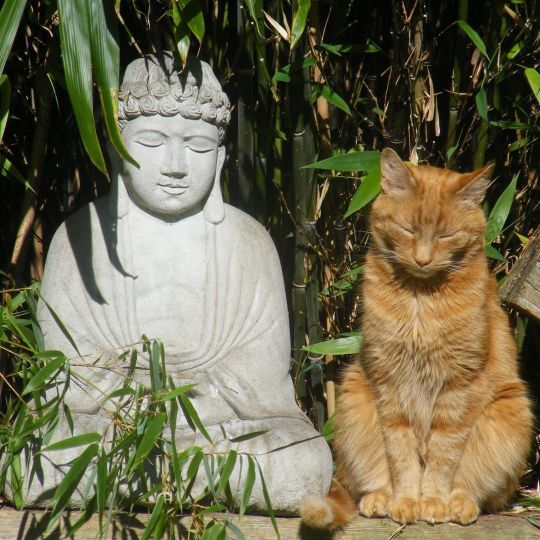
We now find ourselves in an age in which more people are practicing yoga than ever before, the term yoga here having become more or less synonymous with postural āsana practice. There are a bewildering array of yoga styles out there, each one trying to make their mark. Yoga appears in glossy magazines and on YouTube and TV programmes and yoga studios have cropped up all over the place in most cities. At least 12,000 ‘yogis’ turn up at Times Square in New York twice a year to practice āsana en-masse. These days it sometimes feels like almost everyone is doing yoga (an exaggeration, I know). Yet, the question has to be asked, is what they are ‘doing’ really yoga?
To answer this question, it may be useful to try and more clearly define what we mean by ‘yoga’. This in itself is a tricky business! First off, is there something tangible, a set of practices and worldviews that we can point to and say conclusively ‘ah-ha, that’s yoga’? Or does the term yoga, as I suspect, refer to something more encompassing, more primordial even, to that yearning to find one’s place in the universe that has arisen amongst all humans in all times and cultures? These days we often hear people say something like “I’m off to do my yoga”. In the very early history of yoga this phrase would not have made much sense. Mostly, yoga was not something you did, but more often referred to a state of being, something you were at the core of your being, and the word was often used interchangeably with samādhi. I think it is important to fully understand this point, that yoga is ultimately the goal, that which we aim to attain, through whatever means and whatever practices seem right for us. The truth is, in its long history yoga can and has been defined in many different ways, as even a cursory look through this history will attest.

We might begin this journey sifting through the rather questionable ‘evidence’ presented by pre-Vedic archaeological finds from the Indus Valley Civilisation and early Vedic texts, where we meet the long-haired sages and vrātyas who some claim to be proto-yogis. Much scholarly research is now suggesting that the origins of the practices and concepts of yoga may have originated amongst the ascetic groups known as the śramaṇas, such as the Buddhists, Jains and Ājīvikas, although they didn’t actually use the term yoga. Our next hard evidence of yoga appears in the genre of texts known as the Upaniṣads where the first clear reference to yoga (in the Kaṭha Upaniṣad) defines it as firm restraint of the senses, a state in which one becomes completely undistracted by the outside world. Within the Bhagavad Gītā, we see yoga defined in a multitude of ways, including in this sense-withdrawal guise, but also as separation from suffering and also as ‘skill in action’ in the context of karma yoga. In Sāṃkhya and subsequently in the Yoga Sūtras the aim of yoga becomes ‘the stilling of the turnings of mind’ and the separation or isolation (kaivalya) of our true self or puruṣa from the everyday material world of prakṛti, and explicitly not becoming ‘one with everything’ which is in fact a more Vedāntic, Tantric and New Age notion.
Later on, yoga becomes inflected with a new set of meanings from the Nondual Śaiva Tantric traditions. The aim of yoga here becomes any practice aimed towards the achievement of that heightened state of awareness where one can perceive the Divine in all things, all situations, and all beings, including oneself. Later still, we come to the tradition of Haṭha yoga. Ironically, the name of this style of yoga which is now usually promoted as a ‘gentle’ yoga in most yoga studios, actually literally means something like ‘forceful yoga’. The overarching aim here remains one of ultimate liberation, but to reach this all kinds of bodily practices are employed, and in some strands of the tradition at least these are geared towards raising the kuṇḍalinī energy up the suṣumṇā nāḍi, awakening the c̣akras as it goes. Here, the division of four yogas, with rāja yoga placed highest, first appears. Though bodily health and longevity are promised as benefits of Haṭha yoga these are hardly seen as the ultimate goal. Indeed, it can be said with some confidence that health related aims (admirable as these may be) do not take on any considerable significance until we get to the present age, within the last century or so. Nowadays, yoga is very much embedded within the Health and Wellbeing industry and we have seen the rise of ‘fitness yoga’, for want of a better term.
So, what is yoga, and can it even be said to have a definable essence? For me, yoga describes a state of being that is innate, natural and primordial. Yoga is not even something to strive for or towards because each one of us has yoga at the very core of our being. In prehistoric times I believe we were all naturally engaged in yoga, and by saying this I certainly don’t want to portray a rose-tinted view of the past in which life was perfect and peaceful, that’s absurd, but I do think we would have been more deeply connected with the source, with the ground of Being, that puruṣa, brahman, Śiva, God, Pure Awareness, call it what you will. In the modern technological age, we have more and more distractions that prevent us from realising and abiding in this true state. This does not necessarily mean that the modern age is all bad, again that’s just absurd, it just means we have to work much harder to regain this state of yoga. And again, this is not really the right wording, because we are not actually re-gaining anything, as yoga is always with us, it is simply veiled or covered to varying degrees.

Having as I do a preference for the Nondual Śaiva Tantra view of things, I also happen to believe that rediscovering the state of yoga does not mean renouncing or closing oneself off from the world, to the contrary, it means opening up fully to the universe and all the wondrous potentiality it contains. If one could see the Divine working creatively through everything (including oneself) in every single moment, whether enjoying a beautiful beach, cleaning a toilet, or doing a headstand or whatever one does in life… then one would know one was truly living in yoga. We might rediscover that lost state through dancing or whilst washing the dishes, we might rediscover it through sitting in deep meditation, and yes, we might rediscover it through standing on our heads! Who cares how we find it? Yoga is a destination with many paths, and now is hardly the time to bicker about which path is superior.
As a species, we stand at a crossroads. Our egotistical desire to control and manipulate everything has left us at the edge of destruction. I know it all sounds a bit grand but maybe, just maybe, rediscovering this state of yoga, this state of equilibrium and joyous exuberance in all-pervading Divinity, will be the thing that can save us...
By Dr. Benjamin Major
#yoganaturesheffieldblog#yoga philosophy#yogaasastateofbeing#yogahistory#yogainspiration#yogaforrelaxation#nonduality#whatisyoga#yogaislife
0 notes
Text


Learning at AatmYogashala yoga school may be a life-changing experience that extends beyond only learning yoga postures. It might entail studying more about the philosophy and history of yoga, establishing a personal practise, and learning how to teach others.
Namaste and welcome! We're excited to share the transformative power of yoga with you.
𝐃𝐌 𝐮𝐬 𝐟𝐨𝐫 𝐌𝐨𝐫𝐞 𝐄𝐧𝐪𝐮𝐢𝐫𝐢𝐞𝐬 & 𝐃𝐞𝐭𝐚𝐢𝐥𝐬:
𝐖𝐞𝐛𝐬𝐢𝐭𝐞: https://aatmyogashala.com
𝐂𝐚𝐥𝐥 𝐎𝐑 𝐖𝐡𝐚𝐭𝐬𝐀𝐩𝐩: +91-8445993766
𝐄-𝐦𝐚𝐢𝐥: [email protected]
#yogaschool#yogastudent#yogapractice#yogaphilosophy#yogahistory#yogastyles#yogaposes#teachertraining#yogattc#yogateachertraininginrishikesh#AatmYogashala#Aatmyogashram
0 notes
Text
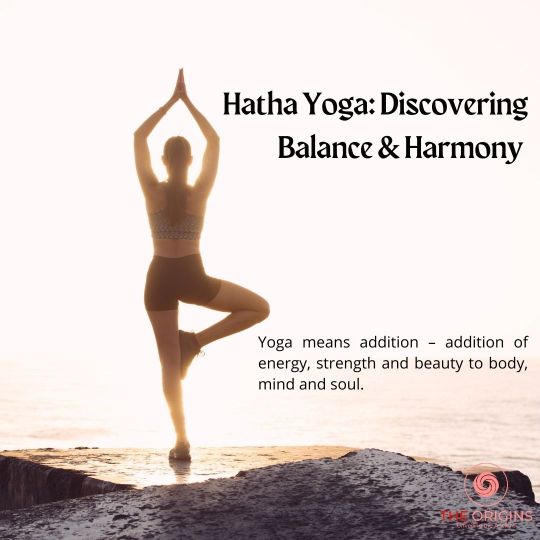
Hatha yoga is a branch of yoga that focuses on physical postures, breathing techniques, and meditation. The word "hatha" comes from the Sanskrit words "ha" meaning sun and "tha" meaning moon, and it is believed that hatha yoga helps to balance the two energies in the body.
Hatha yoga is a very versatile practice, and there are many different styles of hatha yoga. Some styles focus on slow, gentle movements, while others are more vigorous. There are also hatha yoga classes that are specifically designed for beginners, as well as classes for more experienced practitioners.
The benefits of hatha yoga are many. It can help to improve flexibility, strength, and balance. It can also help to reduce stress, improve sleep, and boost the immune system. Additionally, hatha yoga can be a very spiritual practice, and it can help to connect you with your inner self.
Here are some of the most common steps in a hatha yoga class:
Warm-up: The warm-up is typically a series of gentle movements that help to prepare the body for more challenging postures.
Postures: The postures, or asanas, are the heart of a hatha yoga class. There are many different asanas, and they are typically held for a few breaths each.
Breathing techniques: Breathing techniques, or pranayama, are an important part of hatha yoga. There are many different pranayama techniques, and they can help to calm the mind and improve focus.
Meditation: Meditation is often the final part of a hatha yoga class. Meditation can help to relax the mind and body, and it can also help to cultivate mindfulness.
If you are interested in trying hatha yoga, there are many different ways to get started. You can find hatha yoga classes at most yoga studios, and there are also many online resources that can teach you the basics of hatha yoga.
Here are some tips for getting started with hatha yoga:
Start slowly and gradually increase the intensity of your practice.
Listen to your body and don't push yourself too hard.
Find a style of hatha yoga that you enjoy.
Be patient and consistent with your practice.
Hatha yoga is a great way to improve your physical and mental health. It is a gentle and accessible practice that can be enjoyed by people of all ages and fitness levels. If you are looking for a way to relax, improve your flexibility, and connect with your inner self, then hatha yoga is a great option for you
3 notes
·
View notes
Text
youtube
Health Matters Live: International Yoga Day 2023 #yogaday2023 #internationalyogaday2023
Welcome to "Health Matters Live," your ultimate source for live news updates on crucial health topics! Join us for an engaging live-streaming session as our expert panellists provide opinions and insights on International Yoga Day! On the auspicious occasion of International Day of Yoga, we are uploading the live recording of your exhilarating yoga health event that took place on June 21st. This video will showcase yoga's power and its anticipated benefits to your well-being. Share it within the community and support the essential presence of yoga displayed by our members during this enlightening gathering. This video will manifest your support for natural and psychological health. Let's participate in this live yoga celebration and embrace a healthy and fulfilling lifestyle. Stay informed, ask questions, and gain valuable insights into the significance and practice of yoga on this International Yoga Day. We request you to sign up for this form to show interest in the yoga day package, https://docs.google.com/forms/d/e/1FA... Your feedback will help us provide content relevant to your health-promoting interests. Before watching the video, do not forget to SUBSCRIBE to this channel to receive many more tips. For professional help and tools, download our mobile app: Android: http://bit.ly/3JACQOb Apple: https://apple.co/3I0QKbe Explore at www.raphacure.com or write to [email protected]. Thankyou from RaphaCure for organizing this refreshing event. We had a great time . Credits : https://www.instagram.com/thedeepikaw... #HealthMattersLive #HealthNewsUpdates #StayInformed #LiveHealthDiscussion #MedicalExpertPanel #HealthcareAdvancements #AskTheExperts #InternationalYogaDay #YogaHistory #ImportantYogis #YogaAsanas #SoundTherapy #azadikaamritmahotsavdrawing #YogaDay #HealthProgram #PowerOfYoga #InternationalYogaDay #YogaDay #InternationalYogaDay #YogaCelebration #HealthAndWellness #YogaForLife #YogaCommunity #YogaInspiration #YogaJourney #MindBodyBalance #HealthyLifestyle #FitnessGoals #YogaEveryday #YogaBenefits #YogaPractice #InnerPeace #YogaLove #YogaLife #YogaMotivation #YogaForHealth #YogaPoses #YogaEvent #YogaTogether #YogaForAll #YogaAwareness #YogaMeditation #YogaForMindAndBody #yogaislife #internationalyogaday2023 #raphacure #raphalive #raphaclinic #pmoindia #g20india Latest news update: Latest news up The latest news update today Latest news updates Malayalam Latest news updates in Telugu Latest news updates in Hindi The latest news update
#HealthMattersLive#HealthNewsUpdates#StayInformed#LiveHealthDiscussion#MedicalExpertPanel#HealthcareAdvancements#AskTheExperts#InternationalYogaDay#YogaHistory#ImportantYogis#YogaAsanas#SoundTherapy#azadikaamritmahotsavdrawing#YogaDay#HealthProgram#PowerOfYoga#YogaCelebration#HealthAndWellness#YogaForLife#YogaCommunity#YogaInspiration#YogaJourney#MindBodyBalance#HealthyLifestyle#FitnessGoals#YogaEveryday#YogaBenefits#YogaPractice#InnerPeace#YogaLove
0 notes
Photo

“It’s a sound that validates oneness and harmony. We chant it because yogis have for thousands of years. And when we chant it, we’re connecting with those yogis in a ritual way, and drawing upon the support of the practices they’ve been doing for a long, long time.”⠀ .⠀ Paramahansa Yogananda⠀ .⠀ .⠀ .⠀ #aum #om #yoga #tradition #history #yogahistory #yogalineage #yogatradition #ritual #focus #iyengaryoga #bhakti #bhaktiyoga #oneness #harmony #yogajivana108 #yoganorthcote #northcoteyoga #yogamelbourne #melbourneyoga #yogaaustralia #yogaeverywhere #yogalife #yogalove #liveinyoga
#yogalife#tradition#bhakti#oneness#yogaeverywhere#liveinyoga#ritual#yoga#yogatradition#yogajivana108#focus#bhaktiyoga#om#history#aum#melbourneyoga#yogaaustralia#yogahistory#iyengaryoga#yogamelbourne#northcoteyoga#yogalove#yogalineage#yoganorthcote#harmony
2 notes
·
View notes
Text
The Father of Yoga in the Western World, Triumalai Krishnamacharya (1889-1999)
The Father of Yoga in the Western World, Triumalai Krishnamacharya (1889-1999)
Whether you practice the dynamic Vinyasa and Ashtanga series of Pattabhi Jois, the refined alignments of B.K.S. Iyengar, the classical postures of Indra Devi, or the actualized self-discovery Viniyoga methods of T.K.V. Desikachar, your practice stems from one source, a five-foot, two-inch Brahmin born more than a hundred years ago in a small South Indian village. He never crossed an ocean, but…
View On WordPress
0 notes